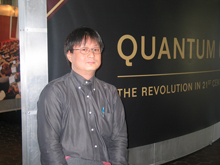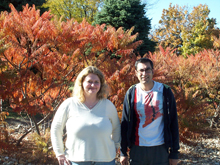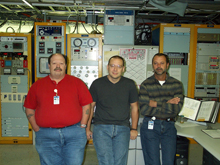 | Thursday, October 20, 2005 |
|
Thursday, October 20
Friday, October 21 |
|
Extended Forecast |
Secon Level 3 |
|
Thursday, October 20 -Minnesota Wild Rice w/Chicken -Tuna Melt on Nine Grain -BBQ Ribs -Chicken Casserole -Buffalo Chicken Wrap -Mexican Pizza -Chicken Pecan Salad The Wilson Hall Cafe accepts Visa, Master Card, Discover and American Express at Cash Register #1. |
|
Thursday, October 20 Dinner -Tortilla Soup -Grilled Spiced Lamb with Red Pepper Sauce -Saffron Vegetables -Profiteroles
Wednesday, October 26
Chez Leon Menu |
| Fermilab Today is online at: http://www.fnal.gov/today/ Send comments and suggestions to today@fnal.gov Fermilab Today archive Hurricane Relief Page Fermilab Today PDF Version Fermilab Result of the Week archive Fermilab Safety Tip of the Week archive Linear Collider News archive Fermilab Today classifieds Subscribe/Unsubscribe to |
| 4th Round of TeV4LHC Workshops Begins Today |
|
|
Starting today, Fermilab will host the fourth round of the TeV4LHC workshops, meant to benefit the experiments at CERN's Large Hadron Collider through the experience gained from the world's highest energy accelerator. "The idea is to use the knowledge we are collecting at the Tevatron to be better prepared for physics of the LHC," said Marcela Carena, a Fermilab theoretical physicist who is organizing the workshop with Stephen Mrenna, of the Computer Division.
About 150 people are expected to attend the three-day workshop to improve analysis techniques at the LHC by studying Tevatron data. Topics will include electroweak interactions, the Higgs boson, QCD and searches for new physics. The opening workshop was held at Fermilab last September with follow-up sessions at Brookhaven National Laboratory in February and at CERN in April.
|
| CDF's Maruyama: Top Quark
Excitement Still Ahead
For more reflections on the top quark's discovery, attend the Top Turns Ten celebration from 1-5 p.m. Friday in Ramsey Auditorium. | ||
|
To Taka Maruyama, the most exciting moment in top quark research wasn't its discovery ten years ago. It's right now. With years of strong Fermilab top quark data under CDF's belt, Maruyama is most enthralled by what discoveries the famous particle can help uncover today and in the future. Maruyama, one of CDF's conveners for top quark physics, was a student at Japan's Tohoku University when Fermilab made headlines about the top quark discovery. "It had a very big impact," he said. "Even in Japan it was on the front page of the newspapers." Maruyama joined the CDF collaboration in 2002 as a postdoc from the University of Chicago. "The properties of the top quark are still an interesting part of our field," Maruyama said. "Indeed, the last two or three years have been most exciting for the top quark." Tevatron luminosity, the measurement of particle collisions, has greatly increased since Run II began. Maruyama said that with more data available for top quark analysis, scientists can conduct more precise measurements of top mass, decay and production cross section.
With improved top quark measurements, scientists also are able to indirectly measure the Higgs mass, Maruyama said. Those measurements could aid the search for the actual Higgs boson at the Large Hadron Collider. "With what we have learned about the top, the LHC experiments can imagine what mass the Higgs boson has and they can pin down what mass range they should search."
|
Help Save Energy at Fermilab October is "Energy Awareness Month" throughout DOE. In the coming weeks, Fermilab Today will run a series of tips and reminders so we can all do our part. |
|
|
In the wake of Hurricanes Katrina and Rita, the president has directed all Federal Agencies to do their part to save as much energy as possible. Here at Fermilab, even small changes will make a difference. During the winter months, consider opening blinds to let in sunlight and switching of extra lights when they are not needed. Make new friends at the lab by arranging carpools, and only print and photocopy what you really need on paper. "As part of the national response to Hurricanes Katrine and Rita," Stephen Webster of the DOE Fermi Site Office reminds us, "We all need to do our part." It's always been a good idea to save energy, but this plea comes at an especially crucial time for the energy infrastructure in the Gulf of Mexico, which was forced to take offshore oil production and three-quarters of natural gas production offline after the hurricanes ripped through the region. Fermilab is poised to make a real difference during the coming winter. In an October 13 message, the United States Secretary of Energy, Samuel Bodman, emphasized the important role that agencies like Fermilab, which are located in the colder regions of the country, will play in this effort. Steve Krstulovich, Fermilab's energy conservation expert explained, "This is one of those rare opportunities where we can actually do something to improve our lot, both individually and nationally."
|
|
From news.telegraph, October 16, 2005: How Katie put the science back into songwriting For millions of listeners across the world, the enchanting lyrics proved an instant hit. But for one physicist, some of the lyrics of Katie Melua's single Nine Million Bicycles was light years away from fact - and something had to be done. Katie Melua: no right to 'guess' at the age of the universe Simon Singh took issue with the second verse of the song which stated that, at a "guess", the edge of the universe was "12 billion light years away". Now, after publicly correcting her statistical error, the 21-year-old musician agreed to re-record the track, changing the lyric to the more factual 13.7 billion light years. Mr Singh, 41, who has recently written a book on the history of cosmology called Big Bang, described the flaw as "deeply annoying".
He said yesterday: "It's the word 'guess' that I rail against. I can guess the lottery numbers for next week but the edge of the universe is better than that.
|
| What do Z's and b's Tell us About the Higgs Boson? | ||
|
The Higgs boson is the only Standard Model particle not yet observed. At the Tevatron the Higgs can be produced simultaneously with a Z-boson. This is one of the best ways to find the Higgs since it involves the detection of an easily identifiable Z-boson plus two b-quarks from the Higgs decay. Measurements of b-quark production also provide one of the best testing grounds for the theory of the strong interaction, quantum chromodynamics (QCD). Here we show the first CDF measurement of the simultaneous production of a Z-boson and a b-quark at CDF. Z-bosons can be produced along with an up, down, charm, strange or bottom quark which appears in the calorimeter detector as a collimated stream of particles called a "jet." Using tracks from these particles inside the jet one can reconstruct an "invariant mass" of the tracks, which is related to the mass of the quark that produced the jet. B quarks are the heaviest of these quarks, and so jets with a large mass are most likely originating from b-quarks. A characteristic signature of a b quark is a second vertex in the jet at a distance of about 0.5 cm from the primary interaction point. This decay vertex is reconstructed using the high precision CDF silicon detector. The invariant mass of the tracks at this secondary vertex is shown in the figure for the 101 events where a secondary vertex is observed. By fitting this distribution the fractional contribution of b-quarks is extracted. As a result we find that only about 2 percent of jets in Z-boson events are b-jets, in good agreement with the QCD prediction. This result is the first measurement of this rate without any assumptions about the contribution from the other quarks. Since this measurement increases our understanding of events which mimic Higgs production, it will help refine the search to discover the Higgs boson at the Tevatron. |
||
| ||
| Result of the Week Archive |
e-VLBI Measures Earth and Sky
Read More
|
|
October 17 - 19 - During the 48 hour period, two stores provided 20 hours and 22 minutes of luminosity. - Vacuum bursts plague TeV, Recycler, and MI - Pbar pulse magnet ground faulted - ComEd power glitch aborts store and stash - TeV vacuum leak hunted
Read the Current Accelerator Update
|
|
Yoga Classes start October 25
Classes are held on Tuesdays from 12:00 p.m. to 1:00 p.m. in the Auditorium at Wilson Hall. The eight-week session will begin October 25 and run through December 13. The cost for this session is $80.00. Registration can be done by mail, fax x5207, in person in the Recreation Office or if you are using a credit card for payment, by phone. These classes DO NOT require a recreation membership. More Information
Volunteer for Girl Scout Projects
|




